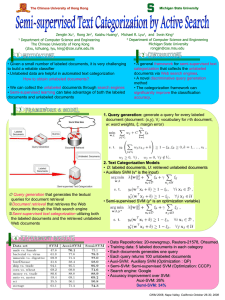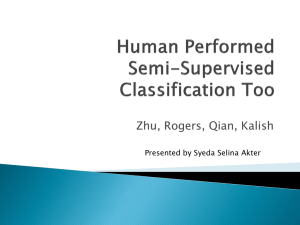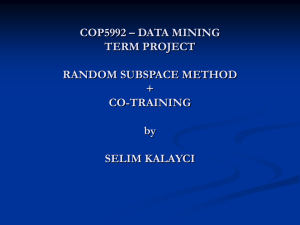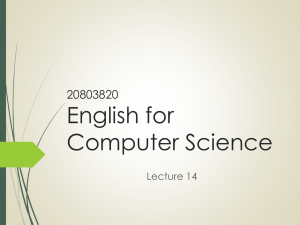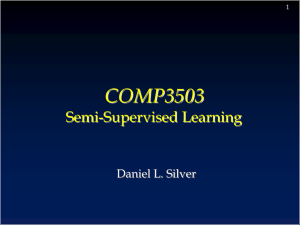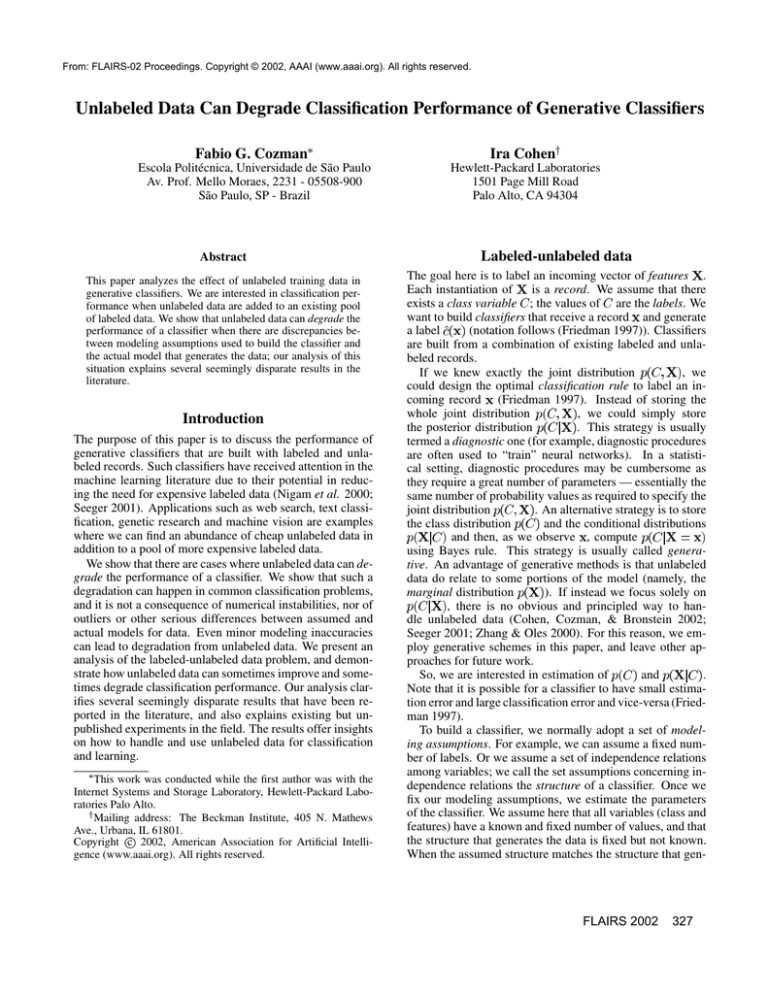
From: FLAIRS-02 Proceedings. Copyright © 2002, AAAI (www.aaai.org). All rights reserved.
Unlabeled Data Can Degrade Classification Performance of Generative Classifiers
Fabio G. Cozman
Ira Cohen
Escola Politécnica, Universidade de São Paulo
Av. Prof. Mello Moraes, 2231 - 05508-900
São Paulo, SP - Brazil
Hewlett-Packard Laboratories
1501 Page Mill Road
Palo Alto, CA 94304
Abstract
This paper analyzes the effect of unlabeled training data in
generative classifiers. We are interested in classification performance when unlabeled data are added to an existing pool
of labeled data. We show that unlabeled data can degrade the
performance of a classifier when there are discrepancies between modeling assumptions used to build the classifier and
the actual model that generates the data; our analysis of this
situation explains several seemingly disparate results in the
literature.
Introduction
The purpose of this paper is to discuss the performance of
generative classifiers that are built with labeled and unlabeled records. Such classifiers have received attention in the
machine learning literature due to their potential in reducing the need for expensive labeled data (Nigam et al. 2000;
Seeger 2001). Applications such as web search, text classification, genetic research and machine vision are examples
where we can find an abundance of cheap unlabeled data in
addition to a pool of more expensive labeled data.
We show that there are cases where unlabeled data can degrade the performance of a classifier. We show that such a
degradation can happen in common classification problems,
and it is not a consequence of numerical instabilities, nor of
outliers or other serious differences between assumed and
actual models for data. Even minor modeling inaccuracies
can lead to degradation from unlabeled data. We present an
analysis of the labeled-unlabeled data problem, and demonstrate how unlabeled data can sometimes improve and sometimes degrade classification performance. Our analysis clarifies several seemingly disparate results that have been reported in the literature, and also explains existing but unpublished experiments in the field. The results offer insights
on how to handle and use unlabeled data for classification
and learning.
This work was conducted while the first author was with the
Internet Systems and Storage Laboratory, Hewlett-Packard Laboratories Palo Alto.
Mailing address: The Beckman Institute, 405 N. Mathews
Ave., Urbana, IL 61801.
Copyright c 2002, American Association for Artificial Intelligence (www.aaai.org). All rights reserved.
Labeled-unlabeled data
The goal here is to label an incoming vector of features .
is a record. We assume that there
Each instantiation of
exists a class variable ; the values of are the labels. We
want to build classifiers that receive a record and generate
(notation follows (Friedman 1997)). Classifiers
a label
are built from a combination of existing labeled and unlabeled records.
If we knew exactly the joint distribution
, we
could design the optimal classification rule to label an incoming record (Friedman 1997). Instead of storing the
whole joint distribution
, we could simply store
. This strategy is usually
the posterior distribution
termed a diagnostic one (for example, diagnostic procedures
are often used to “train” neural networks). In a statistical setting, diagnostic procedures may be cumbersome as
they require a great number of parameters — essentially the
same number of probability values as required to specify the
joint distribution
. An alternative strategy is to store
and the conditional distributions
the class distribution
and then, as we observe , compute
using Bayes rule. This strategy is usually called generative. An advantage of generative methods is that unlabeled
data do relate to some portions of the model (namely, the
marginal distribution
). If instead we focus solely on
, there is no obvious and principled way to handle unlabeled data (Cohen, Cozman, & Bronstein 2002;
Seeger 2001; Zhang & Oles 2000). For this reason, we employ generative schemes in this paper, and leave other approaches for future work.
and
.
So, we are interested in estimation of
Note that it is possible for a classifier to have small estimation error and large classification error and vice-versa (Friedman 1997).
To build a classifier, we normally adopt a set of modeling assumptions. For example, we can assume a fixed number of labels. Or we assume a set of independence relations
among variables; we call the set assumptions concerning independence relations the structure of a classifier. Once we
fix our modeling assumptions, we estimate the parameters
of the classifier. We assume here that all variables (class and
features) have a known and fixed number of values, and that
the structure that generates the data is fixed but not known.
When the assumed structure matches the structure that gen-
FLAIRS 2002
327
erates the data, we say the structure is “correct.”
The labeled-unlabeled data problem is a combination of
both supervised and unsupervised problems (Duda & Hart
1973). Suppose that we have a classifier with modeling
assumptions that exactly match the model generating data.
Early work has proved that unlabeled data can lead to improved maximum likelihood estimates even in finite sample cases (Castelli & Cover 1996). (Shahshahani & Landgrebe 1994) emphasize the variance reduction caused by unlabeled data under the assumption that bias is zero; their
conclusion is that unlabeled data must help classification
(similar conclusion in (Zhang & Oles 2000)). In general,
unlabeled data can help in providing information for the
(Cohen, Cozman, & Bronstein
marginal distribution
2002). Castelli and Cover have investigated the value of
unlabeled data in an asymptotic sense, with the assumption
that the number of unlabeled records goes to infinity, and do
so faster than the number of labeled records (Castelli 1994;
Castelli & Cover 1995; 1996). They prove that, assuming
modeling assumptions are correct, for the classifier, classification error decreases exponentially with the number of
labeled records, and linearly with the number of unlabeled
records1 (similar analysis in (Ratsaby & Venkatesh 1995)).
The message of previous work is that unlabeled data must
help as long as modeling assumptions are correct.
On top of the theoretical work just described, several empirical investigations have suggested that unlabeled training data do improve classification performance. (Shahshahani & Landgrebe 1994) describe classification improvements with spectral data; Mitchell and co-workers report
a number of approaches to extract valuable information
from unlabeled data, from variations of maximum likelihood estimation (Nigam et al. 2000) to co-training algorithms (Mitchell 1999). Other publications report on EMlike algorithms (Baluja 1998; Bruce 2001; Miller & Uyar
1996) and co-training approaches (Collins & Singer 2000;
Comité et al. 1999; Goldman & Zhou 2000). There have
also been workshops on the labeled-unlabeled data problem
(at NIPS1998, NIPS1999, NIPS2000 and IJCAI2001).
Overall, these publications and meetings advance an optimistic view of the labeled-unlabeled data problem, where
unlabeled data can be profitably used whenever available. A
more detailed analysis of current results does reveal some
puzzling aspects of unlabeled data. In fact, the workshop
held at IJCAI2001 witnessed a great deal of discussion on
whether unlabeled data are really useful.2
Three results are particularly interesting:
1. Shahshahani and Landgrebe describe experiments that
demonstrate how unlabeled data can help mitigate the
“Hughes phenomenon” (degradation of performance
when features are added), but they also report situations
1
Castelli and Cover assume identifiability, a property that may
fail when features are discrete, as in many machine learning applications (Duda & Hart 1973). Lack of identifiability does not seem
to be a crucial matter in the labeled-unlabeled problem, as we made
extensive tests with discrete models and observed behavior consistent with Gaussian (identifiable) models.
2
This fact was communicated to us by George Forman.
328
FLAIRS 2002
where unlabeled data degrade performance. They attribute such cases to deviations from modeling assumptions; for example, “outliers, . . . , and samples of unknown
classes” — they even suggest that unlabeled records
should be used with care, and only when the labeled data
alone produce a poor classifier.
2. (Baluja 1998) used Naive Bayes (Friedman 1997) and
TAN classifiers (Friedman, Geiger, & Goldszmidt 1997)
to obtain excellent classification results, but there were
cases where unlabeled data degraded performance.
3. In work aimed at classification of documents, (Nigam et
al. 2000) used Naive Bayes classifiers with fixed structure and a large number of features. Nigam et al actually discuss situations where unlabeled data degrade performance, and propose several techniques to reduce the
observed degradation. Nigam et al do not attempt to completely explain the reasons for degradation, but suggest
that the problem might have been a mismatch between
the natural clusters in feature space and the actual labels.
The present paper can be understood as a natural sequence
on Nigam et al investigation, where we verify and explain
the conditions that lead to degradation with unlabeled data.
In fact, intrigued by these existing results, we conducted a
series of experiments aimed at understading the value of unlabeled data (Cohen, Cozman, & Bronstein 2002). In short,
the experiments do indicate that unlabeled data can have a
deleterious effect in some situations. Consider Figure 1,
which shows two typical results. Here we estimated the parameters of Naive Bayes classifiers with 10 features using
the EM algorithm (Dempster, Laird, & Rubin 1977). Figure 1 shows classification performance when the underlying
model actually has a Naive Bayes structure (left), and when
the underlying model follows a TAN model (right). The result is clear: when we estimate a Naive Bayes classifier with
data from a Naive Bayes model, more unlabeled data help;
when we estimate a Naive Bayes classifier with data that do
not come from a corresponding structure, more unlabeled
data can degrade performance.
The previous discussion raises some questions: Can unlabeled data actually degrade performance, and if so, how, and
why?
The effect of unlabeled data
In this section we discuss the effect of unlabeled data on
classification error. To visualize the effect of unlabeled
data, we propose a new strategy for graphing performance
in the labeled-unlabeled data problem. Instead of fixing the
number of labeled records and varying the number of unlabeled records, we propose to fix the percentage of unlabeled
records among all training records. We then plot classification error against the number of training records. Call such
a graph a LU-graph. We introduce LU-graphs with an example.
Consider a situation where we have a class variable
with labels and , and probability
. We
also have two real-valued features
and
with distributions:
0.13
0.4
0.35
30 Labeled
Probability of error
Probability of error
0.12
0.11
0.1
0.09
0.08
0.3
30 Labeled
0.25
300 Labeled
0.2
300 Labeled
0.07
3000 Labeled
0.06 0
10
0.15
1
10
2
3
10
10
Number of Unlabeled records
4
3000 Labeled
0
10
10
1
10
2
3
4
10
10
Number of Unlabeled records
10
Figure 1: Naive Bayes classifier from data generated from a Naive Bayes model (left) and a TAN model (right). Each point
summarizes 10 runs of each classifier on testing data; bars cover 30 to 70 percentiles.
Classification error: 0%, 50%, 99% unlabeled records
0% unlabeled
50% unlabeled
99% unlabeled
0.4
Classification error (log)
where
denotes a Gaussian distribution with mean
and variance . The problem is identifiable, and there is
and
(
depends on
when
dependency between
). Suppose we build a Naive Bayes classifier for
this problem. Figure 2 shows LU-graphs for 0% unlabeled
records, 50% unlabeled records and 99% unlabeled records.
The LU-graphs for 50% and 99% unlabeled data have an interesting property: their asymptotes do not converge to the
same value, and they are both different from the asymptote
for labeled data. Suppose then that we started with 50 labeled records as our training data. Our classification error
would be about 7.8%, as we can see in the LU-graph for
0% unlabeled data. Suppose we added 50 labeled records,
and we reduced classification error to about 7.2%. Now suppose we added 100 unlabeled records. We would move from
the 0% LU-graph to the 50% LU-graph. Classification error
would increase to 8.2%! And if we then added 9800 unlabeled records, we would move to the 99% LU-graph, with
classification error about 16.5% — more than twice the error
we had with just 50 labeled records.
The fact that classification error has different asymptotes,
for different levels of unlabeled data, can lead to a degradation of performance from the addition of unlabeled data. By
moving from one LU-graph to another, we can either see an
increase or a decrease on classification error, depending on
the slopes of the particular LU-graphs.
It should be noted that in difficult classification problems, where LU-graphs decrease very slowly, unlabeled data
should improve classification performance (unless we have
large amounts of labeled data available). Problems with a
large number of features and parameters should require more
training data, so we can expect that such problems benefit
more consistently from unlabeled data. Examples discussed
by (Nigam et al. 2000) seem to fit this description exactly
— while they suggest that adding features can worsen the
effect of unlabeled data, the opposite should be expected.
This observation also agrees with the empirical findings of
(Shahshahani & Landgrebe 1994), where unlabeled data are
useful as more and more features are used in classifiers.
To understand why and when do unlabeled data produce
asymptotic differences between LU-graphs, we must visualize the geometry of estimation and adopt some assumptions
0.3
0.2
0.1
2
10
3
10
Number of records (log)
4
10
Figure 2: LU-graphs for the example with two Gaussian features. Each point in each graph is the average of 100 trials;
classification error was obtained by testing in 10000 labeled
records drawn from the correct model.
regarding the problem. We simplify the analysis by concentrating on the two extreme LU-graphs, for fully labeled data
and for fully unlabeled data — we should expect that any
asymptotic gap of performance between these two graphs
will be filled by a continuum of LU-graphs (just as the middle graph in Figure 2).
In general, if we do not have the correct modeling assumptions for a classifier, we can obtain a model that only
, regardless of the estimation proceapproximates
dure we employ. We can imagine a set of probability distributions
that represents the models compatible with
modeling assumptions; we are assuming that
. It is easy to imagine such a set of distributions as
a polytope in a high-dimensional space, even though modeling assumptions may induce a more complex set. Figure 3 shows the set
and the “correct” distribution
outside of
. We can also imagine a different set,
, obtained by pointwise marginalization of
. Figure 3 also shows this other set and the distriobtained by marginalization of
.
bution
Our first assumption is that the closest distribution to
FLAIRS 2002
329
for unlabeled data is smaller than for labeled data. When
this performance gap is present, then unlabeled data can degrade performance and the LU-graphs can be used to capture
this phenomenon. Basically, the fact that estimation error
is the guiding factor in building a classifier leads us to use
estimates that are not optimal with respect to classification
error.4
The preceeding discussion indicates that missing labels
are different from missing feature values. Both forms of
missing data degrade estimation performance, but unlabeled
data also affects classification performance directly by in. This introducing bias in the critical parameters
sight clarifies questions on missing/unlabeled data raised by
(Seeger 2001).
Conclusion
Figure 3: Sets of distributions induced by modeling assumptions, and distributions generated by estimation.
in
(which we denote by
) does
in
not correspond to the closest distribution to
(which we denote by
). Here “closeness” between distributions is induced by the estimation procedure, and it need
not be a true norm. To illustrate this assumption, take maximum likelihood estimation in discrete models. Consider first
in
.
the maximum likelihood estimate for
As the number of training records grows without bound, the
, so asymptotempirical distribution converges to
that is
ically we will choose the distribution in
with respect to the Kullback-Leibler diclosest to
vergence (Friedman, Geiger, & Goldszmidt 1997).
Suppose now we compute the maximum likelihood estimate for
subject to the choices in
, the maximum
likelihood solution for unlabeled data. We obtain the closest distribution to
in
with respect to Kullbackinduces estimates
Leibler divergence. Note that
. As Kullback-Leibler divergence and marginaland
need not be
ization do not commute,
equal — and we must focus exactly on the situation where
they are different.3
An additional argument is needed to understand the effect of unlabeled data: We must appreciate the difference
between classification and estimation. Even though adding
more data (labeled and unlabeled) leads to better overall
estimation (with respect to various global measures such
as likelihood, squared-error, variance, Fisher information),
the improvement may be uneven amongst the estimated parameters. Note that for classification, only
matters
is larger than the
(Friedman 1997); if the bias in
, the asymptotic classification performance
bias in
3
Note that when we have correct modeling assumptions,
, and then both estimates must be equal assuming identifiability.
330
FLAIRS 2002
The message of this paper is that unlabeled training data
can degrade classification performance if we have incorrect
modeling assumptions for a classifier. There have been reports that unlabeled data can produce such a degradation, but
explanations offered so far suggest that degradation should
occur in somewhat extreme circunstances. The main point of
this paper is that the type of degradation produced by unlabeled data can occur under common assumptions and can be
explained by fundamental differences between classification
and estimation errors. We propose LU-graphs as an excellent visualization of this phenomenon. An important point
for future investigation is the asymptotic classification performance for various percentages of unlabeled data. Another
point is the search for other possible sources of performance
degradation, particularly when there are severe mismatches
between actual and assumed models.
It certainly seems that some creativity must be exercised
when dealing with unlabeled data. As discussed in the literature (Seeger 2001), currently there is no coherent strategy for handling unlabeled data with diagnostic classifiers,
and generative classifiers are likely to suffer from the effects
described in this paper. More general, or simply different,
approaches could be welcome (Jaakkola, Meila, & Jebara
1999). Future work should investigate whether unlabeled
data can degrade performance in different classification approaches, such as decision trees and co-training. Regardless
of the approaches that are used, unlabeled data are affected
by modeling assumptions, and we can use unlabeled data
to help our search for a correct modeling assumptions. The
present paper should be helpful as a first step in the understanding of unlabeled data and their peculiarities in machine
learning.
Acknowledgements
We thank Alex Bronstein and Marsha Duro for proposing
the research on labeled-unlabeled data and for many suggestions and comments during the course of the work; their
4
This conclusion is not restricted to maximum likelihood estimation, nor does it depend on identifiability. We omit examples
with least-squares estimation and identifiable models due to lack
of space.
help was critical to the work described here. We thank Vittorio Castelli for sending us a copy of his PhD dissertation,
Charles Elkan for sending us his BNB software, and George
Forman for telling us about the IJCAI workshop on unlabeled data. We thank Kevin Murphy for the freely available
BNT system, which we used to generate examples and data.
We coded our own Naive Bayes and TAN classifiers in the
Java language, using the libraries of the JavaBayes system
(freely available at http://www.cs.cmu.edu/˜javabayes). Marina Meila read a preliminary version and sent useful comments.
References
Baluja, S. 1998. Probabilistic modeling for face orientation
discrimination: Learning from labeled and unlabeled data.
In Neural and Information Processing Systems (NIPS).
Bruce, R. 2001. Semi-supervised learning using prior
probabilities and EM. In IJCAI-01 Workshop on Text
Learning: Beyond Supervision.
Castelli, V., and Cover, T. M. 1995. On the exponential value of labeled samples. Pattern Recognition Letters
16:105–111.
Castelli, V., and Cover, T. M. 1996. The relative value of
labeled and unlabeled samples in pattern recognition with
an unknown mixing parameter. IEEE Transactions on Information Theory 42(6):2102–2117.
Castelli, V. 1994. The Relative Value of Labeled and Unlabeled Samples in Pattern Recognition. Ph.D. Dissertation,
Stanford University.
Cohen, I.; Cozman, F. G.; and Bronstein, A. 2002. The
effect of unlabeled data on generative classifiers, with application to model selection. Technical report, HP labs.
Collins, M., and Singer, Y. 2000. Unupervised models
for named entity classification. In Proc. 17th International
Conf. on Machine Learning, 327–334. Morgan Kaufmann,
San Francisco, CA.
Comité, F. D.; Denis, F.; Gilleron, R.; and Letouzey, F.
1999. Positive and unlabeled examples help learning. In
Watanabe, O., and Yokomori, T., eds., Proc. of 10th International Conference on Algorithmic Learning Theory,
219–230. Springer-Verlag.
Dempster, A. P.; Laird, N. M.; and Rubin, D. B. 1977.
Maximum likelihood from incomplete data via the EM algorithm. Journal Royal Statistical Society B 44:1–38.
Duda, R. O., and Hart, P. E. 1973. Pattern Classification
and Scene Analysis. New York: John Wiley and Sons.
Friedman, N.; Geiger, D.; and Goldszmidt, M. 1997.
Bayesian network classifiers. Machine Learning 29:131–
163.
Friedman, J. H. 1997. On bias, variance, 0/1-loss, and
the curse-of-dimensionality. Data Mining and Knowledge
Discovery 1(1):55–77.
Goldman, S., and Zhou, Y. 2000. Enhancing supervised
learning with unlabeled data. In International Joint Conference on Machine Learning.
Jaakkola, T. S.; Meila, M.; and Jebara, T. 1999. Maximum entropy discrimination. Neural Information Processing Systems 12.
Miller, D. J., and Uyar, H. S. 1996. A mixture of experts
classifier with learning based on both labelled and unlabelled data. In Advances in Neural Information Processing
Systems. 571–577.
Mitchell, T. 1999. The role of unlabeled data in supervised
learning. In Proc. of the Sixth International Colloquium on
Cognitive Science.
Nigam, K.; McCallum, A. K.; Thrun, S.; and Mitchell, T.
2000. Text classification from labeled and unlabeled documents using EM. Machine Learning 39:103–144.
Ratsaby, J., and Venkatesh, S. S. 1995. Learning from a
mixture of labeled and unlabeled examples with parametric
side information. In COLT, 412–417.
Seeger, M. 2001. Learning with labeled and unlabeled
data. Technical report, Institute for Adaptive and Neural
Computation, University of Edinburgh, Edinburgh, United
Kingdom.
Shahshahani, B. M., and Landgrebe, D. A. 1994. The
effect of unlabeled samples in reducing the small sample size problem and mitigating the Hughes phenomenon.
IEEE Transactions on Geoscience and Remote Sensing
32(5):1087–1095.
Zhang, T., and Oles, F. 2000. A probability analysis on the
value of unlabeled data for classification problems. In International Joint Conference on Machine Learning, 1191–
1198.
FLAIRS 2002
331


